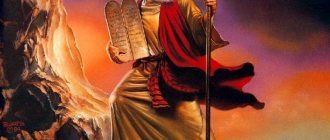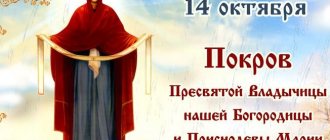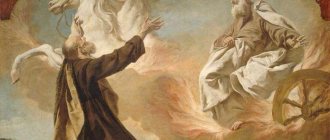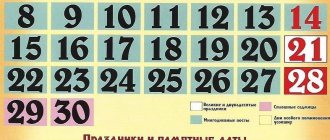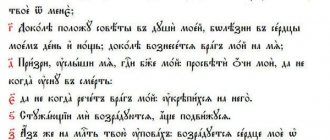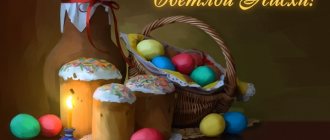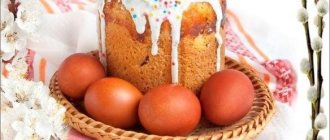Christians all over the world associate the word “Easter” with the most joyful and bright feelings. This concept has several meanings and comes from ancient languages. It is used mainly to refer to the holiday during which the Resurrection of Christ is celebrated. At the same time, the word Easter has several meanings, and scientists put forward different versions about its origin.
In Dahl's dictionary
and. festival of the Jews in memory of their exodus from Egypt. | The lamb that was slain and eaten by the Jews at this festival. | The annual celebration of Christians, in memory of the rise of the Savior from the dead; Bright Sunday of Christ, holy, holy week. | Velikorussk. a consecrated stack of cheese, cottage cheese, which is used to break the fast on this day; and Maloros. Easter cake, consecrated for the same purpose, korovai. What an Easter - wider than Christmas! Who dies on Easter - an egg in his hand (tver.). After Matins on the first day of Easter, they go to celebrate Christ with the departed and bury the egg in the grave. Anyone who sleeps through Matins on the first day of Easter is doused or bathed with water on Monday. Bones from a dead lamb (pig, bird, etc.) are buried in the field so that hail does not hit, south. Easter, relating to this day and celebration. Easter w. a table containing keywords and circles for finding the time of Easter and other moving holidays. Pasochnitsa w. a kind of wooden box, falling apart at the bottom, with decent carved decorations inside, for pressing Easter (cheese, cottage cheese) in it.
"Christ is Risen!" and other Easter greetings in different languages
We all know that Orthodox Christians congratulate each other like this: “Christ is Risen!”, to which the answer certainly follows: “Truly He is Risen!” After this, you are supposed to kiss your interlocutor three times on each cheek in turn. This greeting is called Christening.
Another similar version of congratulations is also allowed, according to the norms of the modern Russian language: “Christ is risen!” - “Truly risen!” It’s just that the first version is much closer to the original church language. Moreover, we still largely live by his canons, although we ourselves may not pay attention.
For example, the prayer “Our Father”, where the word “Father” is used, not “Father”. Let’s remember Pushkin’s famous fairy tale about the goldfish, where she turned to her grandfather: “Well, what do you need, Starche?”
The thing is that for a long time in the Russian language there were not 6, but 7 cases. And the seventh case was called vocative. This case included special forms of nouns like those we discussed above.
And again, it is very difficult to change the popular habit, because we still say: “Lord,” “son,” “daughter,” etc. In most cases these are already colloquial expressions, but it seems they will exist for a very long time.
Now let’s look at how our near and distant neighbors greet each other when they congratulate each other on the great holiday of Easter:
| language | greetings | answer |
| Belorussian | Hrystos uvaskros / uvaskres! | Sapraўdy ўwaskros/ўwaskres! |
| Ukrainian | Christ is risen! | He is truly risen! |
| Czech | Kristus je vzkříšen! Kristus vstal z mrtvých / zmrtvýchvstal! | Vskutku je vzкříšen! Vpravdě vstal z mrtvých! Skutečně vstal! Opravdu zmrtvýchvstal! |
| German | Christus (Der Herr) ist auferstanden! | Er ist wahrhaftig auferstanden! |
| English | Christ is risen! | He is risen indeed! Indeed, He is risen! Truly, He is risen! |
| French | Christ est resuscité! | En vérité/ Vraiment, Il est ressuscité! |
| Italian | Cristo and risorto! | È veramente risorto! |
In each case, the words of greeting and response are translated exactly as in our language. It’s just that in some places the answers are longer, in others they are shorter. And this is no coincidence, because what does Easter mean for Christians? This is the day when the Savior was resurrected.
Therefore, the Easter greeting reflects the whole essence and sacred meaning of this celebration. In a way, this is similar to how we say: “Happy New Year!” With new happiness!" That is, the New Year is a time of good renewal, and Easter is the holiday when Christ rose from the dead and saved all believers from their sins.
In Ozhegov's dictionary
EASTER, -i, f. 1. (P capital). In Judaism: a spring holiday in memory of the exodus of the Jews from Egypt, freed from Egyptian slavery. Bake matzo for Passover. Jewish P. 2. (Capital P). For Christians: a spring holiday associated with faith in the miraculous resurrection of Jesus Christ, celebrated on the first Sunday after the spring equinox and full moon. Service on the first day of Easter. The solemn ringing of bells for Easter. Easter chants. 3. A sweet curd dish in the shape of a tetrahedral pyramid, prepared for the Christian holiday of Easter. Tvorozhnaya p. || adj. Easter, -aya, -oe (to 1 and 2 meanings) and Easter, -aya, -oe (to 3 meanings). Easter week. Warm Easter days. Easter eggs.
Easter
I. NAME
Evp. The word Pesach
in the Bible means, on the one hand, the holiday of P., and on the other, the holiday sacrifice, Passover. lamb This word is derived from the verb, primary. meaning “to limp”, and then received the meaning “to jump over something”, “to leave untouched”. When the Lord struck the firstborn in Egypt, He did not affect the houses of the Jews, but “jumped over” them (Ex. 12:13). P. should remind Jews of this event.
II. EASTER EXODUS
1)
Pharaoh did not want to release the enslaved. Israelites into the desert even after God, in order to break his stubbornness, sent nine plagues on the Egyptians. And then Moses announced to Pharaoh the last, most severe punishment - the death of all Egyptian firstborns (Ex. 11: 4-6). This punishment was supposed to force Pharaoh to release the Israelites from the country (Ex. 11:8);
2)
For this day, the Jews had to carefully prepare, which meant for them the same time. and the test of faith (Heb. 11:28). Starting from the 10th day of the month of Abib, i.e. from the beginning Israel. year (Ex. 12:2), each head of the house had to take care of a one-year-old, without blemish, lamb or kid for his family - a lamb (Ex. 12:3.5). If a family was too small to eat the whole lamb at one time, it had to join a neighboring family so that the number of participants in the meal would be sufficient (Ex. 12:4). The Lamb should have been slaughtered on the 14th of Abib “at evening” (lit. “at dusk”), i.e. between sunset and darkness (Exod. 12:6; Lev. 23:5; Num. 9:3.5.11; cf. Deut. 16:6). A bunch of hyssop was to be anointed with the blood of the lamb on the doorposts and threshold of every Hebrew. home, after which no one had the right to go out the door (Ex. 12:7.22). The lamb had to be baked whole - with head, legs and entrails; it was forbidden to break a single bone, it was forbidden to eat meat raw or boiled (Ex. 12:8.9; cf. Deut. 16:7 and 2 Chron. 35:13; ⇒ Boil, cook, 1). The Passover lamb had to be cooked in the house. Includes Easter. meals included, kp. moreover, unleavened bread and bitter herbs (Ex. 12:8). All leftover food was to be burned (Exodus 12:10), and all participants in the meal were to be ready to set out immediately (Exodus 12:11);
3)
this baked The whole lamb was a symbol of unity and integrity. P. should have eaten in one house (Ex. 12:46) before the Lord, Who “is alone” (Deut. 6:4). In one day He brought about the liberation of Israel (Ex. 12:41), and for this His people must serve Him alone (Deut. 6:5). Unleavened bread (unleavened bread) is quickly baked “bread of disaster” (Deut. 16:3); later they reminded again and again of the haste during the exodus (Ex. 12:34.39); Bitter herbs symbolized the bitterness of life in Egypt. slavery;
4)
when the Israelites celebrated the Passover. meal, the Lord at midnight from the 14th to the 15th of Abib “struck all the firstborn in the land of Egypt” - from the firstborn of Pharaoh to the firstborn of the prisoner, as well as “all the firstborn of the livestock” (Ex. 12:29.30). However, the people of Israel were spared for the Passover. lambs who died in place of the firstborn (cf. ⇒ Lord's Supper, I and II). Thus the way for the ⇒ outcome was opened;
5)
The opinion is often expressed that even before Israel. P. there was an ancient form of this holiday - the spring holiday celebrated annually by nomads; such an assumption can be made on the basis of a number of cultural and historical. data. However, there are no sources earlier than the Bible (or even contemporary ones).
III. PRESCRIPTIONS OF THE LAW ON THE REPEAT OF EASTER
1)
as a constant reminder of the fundamental will save. act of God, about the liberation of Israel. people from Egypt slavery, the Law prescribes that the Israelites annually (Exodus 13:10), from the time of the conquest of the Promised Land (Exodus 12:25; Exodus 13:5), perform P., connecting it with the Feast of Unleavened Bread (Exodus 12:14; Num. 28:16.17; Deut. 16:1–8; cf. also Ezek. 45:21–24). Easter. The lamb was allowed to be slaughtered and eaten only in a special sacred place. place (Deut. 16:5-7), for which all Israel. men were to appear “before the face of God” (Deut. 16:16). All fathers were to explain the meaning of the holiday to their sons (Ex. 13:8). No foreigner, settler or mercenary had the right to participate in this common meal, which reminded the Israelites of the deliverance of their ancestors from slavery and forced them to relive this great event in their hearts again and again (Ex. 12:43.45). Only after completing ⇒ circumcision, a purchased slave, and, if desired, a foreigner, could be allowed to participate in the holiday (Ex. 12:44.48). Anyone who was prevented by ritual impurity or departure from celebrating P. on time could do so a month later (Num. 9:10–12), during the so-called. small P. Anyone who neglected the holiday out of disobedience was subject to the death penalty (Num. 9:13), for he himself excluded himself from Judas. society;
2)
directly adjacent to P. was the Feast of Unleavened Bread, which lasted from 15 to 21 Abib (Exodus 12:18), which, on the one hand, also reminded of the exodus (Exodus 12:17; Deut. 16:3; cf. Deut. 26 :1–11), and on the other hand, it was the holiday of the beginning of the harvest (Lev. 23:10–14). The first and last days of the holiday were Holy Days. meetings, when only such work was allowed that was related to food preparation (Ex. 12:16; Lev. 23:7.8; Num. 28:18.25). Holiday sacrifices were offered daily (Lev. 23:8; Num. 28:19–24), to which were added the voluntary sacrifices of the Israelites (Ex. 23:15). During the entire holiday, it was forbidden to eat or generally keep leavened bread in the house (Ex. 12:18–20; Lev. 23:6). On the trail. the day after the Sabbath (i.e., after the first holiday Saturday), on the second day of the holiday (as the Septuagint and Josephus understand it), the priest offered the first sheaf as a wave offering and a lamb as a burnt offering. Until that time, the fruits of the new harvest were not allowed to be eaten (Lev. 23:9–14). This is probably the first simultaneous sacrifice. symbolized the general beginning of the harvest (Deut. 16:9). As in P., during the Feast of Unleavened Bread, violation of God's commandments was punishable by death (Ex. 12:19);
3)
description of P. and the Feast of Unleavened Bread in Deut. 16 reveals some differences from other regulations concerning these holidays. Here, it seems, it is allowed to bring as Passover. the sacrifices also include cattle (Deut. 16:2; however, perhaps other festival sacrifices are being referred to) and only one day of assembly at the end of the festival is mentioned (Deut. 16:8; see also Exod. 13:6). It was allowed to set off on the trail. morning after Easter. meals (Deut. 16:7), as happened during the P. exodus (Ex. 12:11.39).
IV. EASTER HOLIDAYS IN THE HISTORY OF ISRAEL
The holidays of P. are described in detail only a few times: after the celebration of P. at Sinai (Num. 9:1–5), it was celebrated during the entry into Canaan: then the Israelites celebrated P. in Gilgal and the following. day they ate unleavened bread and fried bread. grains from the harvest of this land, after which the fall of manna stopped (Joshua 5:10–12). The Feast of Unleavened Bread is not mentioned. After the construction of Solomon's temple, P. began to be celebrated regularly (2 Chronicles 8:13). Of great importance are the two feasts of P., celebrated under the kings Hezekiah (2 Chronicles 30) and Josiah (2 Kings 23:21–23; 2 Chronicles 35:1–19), when for the first time after the division of the kingdom the Israelites gathered together again, from all tribes (2 Chron. 30:1.11; 2 Chron. 35:18). However, if P. Hezekiah was performed in the second month (2 Chron. 30:2), according to. regulations, set out in Numbers 9:10, then Josiah celebrated it in the first month, as required by the Law (2 Chron. 35:1). In both cases, P. was followed by the Feast of Unleavened Bread (2 Chronicles 30:21; 2 Chronicles 35:17).
V. PASSOVER IN THE ERA OF LATER JUDAISM
Late Jud. tradition clearly defines the rules for celebrating P., conditioned by specific ones. the situation of the outcome, have lost their relevance: the choice of the lamb on the 10th day of Abib, the anointing of the doors with blood, the ban on leaving the house, the willingness of the participants in the meal to set off. Victim The lambs (the number of which reached several tens of thousands) were slaughtered on the 14th of Nisan, approx. from 15 o'clock day, in the Jerusalem Temple. The lamb was slaughtered by its owner or the one to whom he entrusted to do it; the priests collected the blood into bowls, the bowls were handed to one of the priests, who poured the contents at the foot of the victims. altar. During the slaughter of the lambs, the Levites sang Psalms 112–117 (the so-called hallel
). The lambs were to be eaten within the boundaries of Jerusalem. At the same time, the place of the family community increasingly began to be occupied by a group of pilgrims who came to the holiday and agreed to eat Easter together.
VI. THE EASTER DURING WHICH JESUS DIED
1)
acc. Ev. from John, Jesus died on the 14th of Nisan, on the eve of P. (John 19:14), as a true sacrifice. The Lamb, of whom not a single bone was broken (John 19:36); On the 13th of Nisan, Jesus dined for the last time with His disciples (John 13:1). His burial took place on the evening of Nisan 14 before the onset of Saturday, which is called “great” (John 19:31), apparently because that year the holiday coincided with the calendar Saturday. In this case, the morning of the resurrection corresponds to the first day of the week (John 20:1), when the first fruits of the new harvest were brought in (see above, III.2). Ap. Paul testifies that Christ was sacrificed for us as the Passover. lamb (1 Cor. 5:7) and rose again as the firstborn of the dead (1 Cor. 15:20.23). The dating of the Evangelist John is confirmed by Babylon. The Talmud, which also calls the eve of Passover the day of Jesus' death;
2)
synoptic The Gospels call the day of resurrection the first day of the week (Matt. 28:1; Mark 16:1.2; Luke 24:1), and the day of death is the eve of Saturday (Matt. 27:57.62; Mark 15:42; Luke 23: 54), however, they do not mention the eve of P. At the same time, they unanimously call the day of the Supper of Jesus with his disciples “the first day of unleavened bread,” when they sacrificed the Passover. lamb (Matt. 26:17; Mark 14:12; Luke 22:7), i.e. 14th Nisan. Thus, unlike John and Paul, they place the day of Jesus’ death on the 15th of Nisan, a festive Saturday, thereby simultaneous. turns out to be the eve of the next. followed by calendar Saturday. At the same time, it remains incomprehensible that the Jews who took Jesus into custody had stakes with them (Matt. 26:47.55; Mark 14:43.48; Luke 22:52), which, not being actual weapons, fell under Saturday ban; kp. Moreover, Joseph of Arimathea bought linen in the evening (Mark 15:46), which also could not be done on Saturday;
3)
this contradiction between the testimonies of John and the Synoptics can be resolved in two ways: a) the day on which the Lord’s Supper took place is called “the first day of unleavened bread” (see Matt. 26:17; Mark 14:12; Luke 22:7); this may be due to the fact that the evangelists, as is customary among Jews, attribute the time of the meal, which took place on the 13th of Nisan after 6 pm, to the 14th of Nisan. In this case, a meal was prepared for Jesus without the Passover lamb, since the slaughter of lambs was carried out only for the next day. day; b) it is known that there were disputes between the Pharisees and Sadducees about what day to celebrate the holiday ⇒ Pentecost. Of particular importance here was the circumstance whether P. fell on the day itself. preceding the Sabbath, or on the Sabbath itself. (In the year of Jesus' death, P. was celebrated on Saturday.) It is possible that the disputing parties reached a compromise, as a result of which the Sadducees celebrated their P. a day later than the Pharisees. If we assume that this was the case in the year of Jesus’ death, then Jesus celebrated P. at an earlier date (see Matt. 26:18), i.e. on a day that according to the calendar was Nisan 13, but the Pharisees considered it already Nisan 14, i.e. on the day when P. should have been celebrated according to the Law; and the Sadducean priests considered P. trace. day (John 18:28). Then the death of Jesus, which occurred “about the ninth hour,” i.e. OK. 3 o'clock in the afternoon (see Matthew 27:46.50 and parallel passages), coincides with the official. the hour of the slaughter of the Passover lamb among the Sadducees, while for the Pharisees this day was already the first Saturday of the Feast of Unleavened Bread and at the same time. day of preparation for the calendar Saturday of the current week. If this assumption is correct, then the discrepancy between the data in the Gospels becomes understandable, justified and ceases to seem contradictory.
In the Encyclopedia Dictionary
(Greek pascha, from Hebrew Pesach, lit. - passage), spring Jewish and Christian holiday. In Judaism, it is celebrated in honor of the “exodus” of the Jews from Egypt; the idea of waiting for the Messiah is introduced into the celebration of Easter. In Christianity, the holiday is associated with the doctrine of the resurrection of Jesus Christ. Celebrated by believers on the first Sunday after the spring equinox and full moon. To calculate the dates of celebration, tables (Easter) are compiled. For Orthodox churches, Easter falls between March 22 and April 23 according to the Julian calendar (the so-called Old Style).
Under what circumstances was this holiday established?
However, as many years passed, there were too many Jews. The Egyptians did not like this, they began to oppress them. They were forced to work hard to build pyramids. The Jews suffered and died, and they were also beaten by the overseers.
Then the pharaoh issued an order to destroy all male babies born . But Moses was still saved from execution by his mother, who floated him down the river in a basket. Luckily, just at that time the pharaoh’s daughter went to swim in that river and noticed the baby. She took him to the palace and raised him.
Moses grew up, and the time had come to fulfill the mission God had entrusted to him. The Lord Himself appeared to him in a burning bush (a prototype of the Mother of God) and ordered him to lead the Jewish people out of Egypt.
He went to Pharaoh and made his request. He did not immediately fulfill it, promised and refused many times. For this, Egypt was struck by various disasters.
Terrible executions were carried out on the country one after another:
- The rivers turned to blood.
- Clouds of toads were found in the fields.
- People were eaten by midges, mosquitoes and other blood-sucking creatures in huge numbers.
- The appearance of new insects - dog flies.
- Livestock began to die without exception.
- People were struck by various ulcers.
- Thunder and fiery hail.
- Locusts ate the fruits in huge numbers.
- Darkness for several days.
- Older children in families died.
The last execution turned out to be the most terrible. Pharaoh's son died, and he issued a command to release the Jews.
